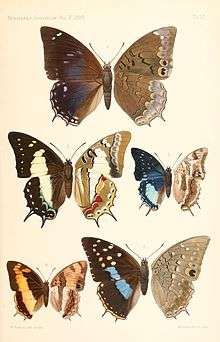Charaxes anticlea
Charaxes anticlea, the small flame-bordered charaxes, is a butterfly in the family Nymphalidae. It is found in Senegal, Guinea-Bissau, Guinea, Sierra Leone, Liberia, Ivory Coast, Ghana, Togo, Nigeria, Cameroon, Gabon, the Republic of the Congo, the Central African Republic, Angola, the Democratic Republic of the Congo, Uganda, Kenya, Tanzania and Zambia.[2] The habitat consists of forests, including dry forests, somewhat degraded forests and dense riverine vegetation.
| Charaxes anticlea | |
|---|---|
 | |
| Figure 4 | |
| Scientific classification | |
| Kingdom: | Animalia |
| Phylum: | Arthropoda |
| Class: | Insecta |
| Order: | Lepidoptera |
| Family: | Nymphalidae |
| Genus: | Charaxes |
| Species: | C. anticlea |
| Binomial name | |
| Charaxes anticlea | |
| Synonyms | |
| |
Both sexes are attracted to fermenting fruit and sucking-trees.
The larvae feed on Acacia poetzi, Acacia pennata, Mezoneuron benthamianum, Acacia goetzei, Acacia brevispica, Mezoneuron welwitschianum and Mezoneuron angolense.
Description
A full description is given by Walter Rothschild and Karl Jordan, 1900 Novitates Zoologicae Volume 7:287-524. page 492 et seq. (for terms see Novitates Zoologicae Volume 5:545-601 )
Subspecies
- Charaxes anticlea anticlea (Senegal, Guinea-Bissau, Guinea, Sierra Leone, Liberia, Ivory Coast, Ghana, Togo, Nigeria)
- Charaxes anticlea adusta Rothschild, 1900 (Democratic Republic of the Congo, Uganda, western Tanzania)
- Charaxes anticlea mwera Vingerhoedt & Bouyer, 1996 (Democratic Republic of the Congo: Shaba)
- Charaxes anticlea proadusta van Someren, 1971 (Nigeria, Cameroon, Gabon, Congo, western Central African Republic, northern Angola, Democratic Republic of the Congo, Zambia
- Charaxes anticlea suna van Someren, 1975 (south-western Kenya)
Taxonomy
Charaxes anticlea is a member of the large species group Charaxes etheocles
Realm
References
| Wikimedia Commons has media related to Charaxes anticlea. |
| Wikispecies has information related to Charaxes anticlea |
- "Charaxes Ochsenheimer, 1816" at Markku Savela's Lepidoptera and Some Other Life Forms
- Afrotropical Butterflies: File H - Charaxinae - Tribe Charaxini
External links
- Images of C. anticlea adusta Royal Museum for Central Africa (Albertine Rift Project)
- Images of C. anticlea mwera Royal Museum for Central Africa (Albertine Rift Project)
- Images of C.anticlea proadusta Royal Museum for Central Africa (Albertine Rift Project)
- Images of C. anticlea suna Royal Museum for Central Africa (Albertine Rift Project)
- Charaxes anticlea images at Charaxes page Consortium for the Barcode of Life subspecies and forms
- African Butterfly Database Range map via search